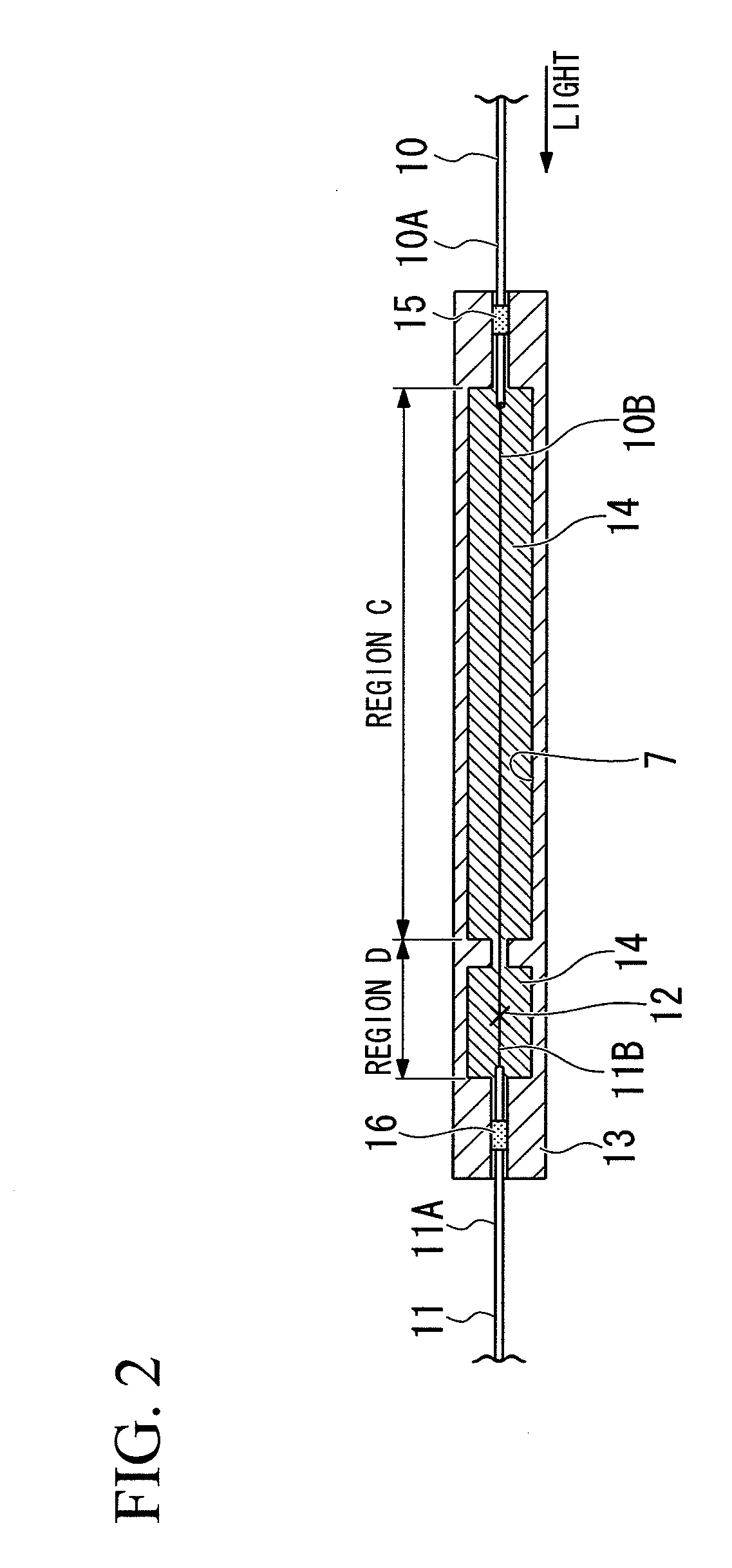Fusion splicing structure of optical fibers
a technology of optical fibers and splicing structures, applied in the direction of optical fibres with multi-layer cores/claddings, optical waveguide light guides, instruments, etc., can solve the problems of increased reliability, and damage to coated portions by large signal loss, so as to prevent the deterioration of fiber coatings and prolong the service life. , the effect of improving reliability
- Summary
- Abstract
- Description
- Claims
- Application Information
AI Technical Summary
Benefits of technology
Problems solved by technology
Method used
Image
Examples
first embodiment
[0045]FIG. 1 shows First Embodiment of the fusion splicing structure of optical fibers of the present invention.
[0046]FIG. 1 shows a double clad fiber 10, a single clad fiber 11, an aluminum block 13 covering a fusion splicing point 12 of the double clad fiber 10 and the single clad fiber 11, and a resin 14 filled into the aluminum block 13. A coating 10A and a coating-removed portion 10B are formed on the double clad fiber 10, and first and second clads to be described later are exposed at the coating-removed portion 10B. A coating 11A and a coating-removed portion 11B are formed on the single clad fiber 11, and a clad to be described later is exposed at the coating-removed portion 11B. The distal end of double clad fiber 10 and that of the single clad fiber 11 are subjected to a fusion splicing for the respective clads at the fusion splicing point 12. The double clad fiber 10 is adhered to the aluminum block 13 at a first adhesion portion 15, and the single clad fiber 11 is adhere...
second embodiment
[0062]FIG. 2 shows Second Embodiment of the fusion splicing structure of optical fibers of the present invention. The fusion splicing structure of optical fibers of the present embodiment includes the same constituents as those used in the splicing structure of First Embodiment, and the same numerals or symbols are given to the same constituents.
[0063]In the fusion splicing structure of optical fibers of the present embodiment, a coating-removed portion 10B in which the first clad of the double clad fiber 10 is exposed is accommodated inside the aluminum block 13 at a region C in front of the fusion splicing point 12 (on the double clad fiber). The coating-removed portion 10B is coated with the resin 14 higher in refractive index than the first clad, and the resin 14 is also enclosed by the aluminum block 13 in which black alumite functioning as the infrared-ray absorbing layer 7 is formed internally.
[0064]Further, at a region D in the vicinity of the fusion splicing point 12, the f...
third embodiment
[0067]FIG. 3 shows Third Embodiment of the fusion splicing structure of optical fibers of the present invention. The fusion splicing structure of optical fibers of the present embodiment includes the same constituents as those used in the splicing structure of First Embodiment, and the same symbols are given to the same constituents.
[0068]In the fusion splicing structure of optical fibers of the present embodiment, excitation light is emitted in a stepwise fashion along the longitudinal direction of the aluminum block 13 at three regions, that is, a region E at the side of the double clad fiber 10 from the fusion splicing point 12, a region F having the fusion splicing point 12 and a region G at the side of the single clad fiber 11 from the fusion splicing point 12, thereby diversifying heat-generating regions.
[0069]The resin 14 to be filled into the region E is lower in refractive index than the clad, and also smaller in NA than the first clad of the double clad fiber 10 through wh...
PUM
 Login to View More
Login to View More Abstract
Description
Claims
Application Information
 Login to View More
Login to View More - R&D
- Intellectual Property
- Life Sciences
- Materials
- Tech Scout
- Unparalleled Data Quality
- Higher Quality Content
- 60% Fewer Hallucinations
Browse by: Latest US Patents, China's latest patents, Technical Efficacy Thesaurus, Application Domain, Technology Topic, Popular Technical Reports.
© 2025 PatSnap. All rights reserved.Legal|Privacy policy|Modern Slavery Act Transparency Statement|Sitemap|About US| Contact US: help@patsnap.com



